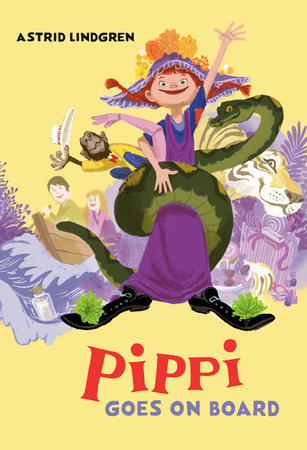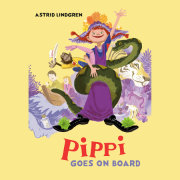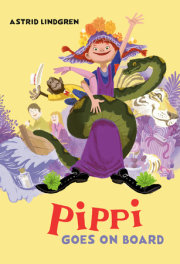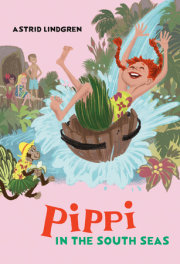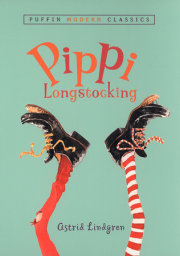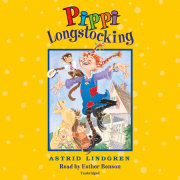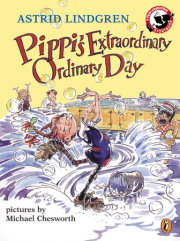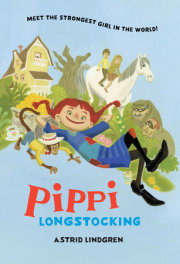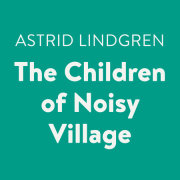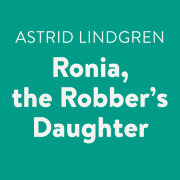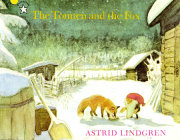1
Pippi Still Lives in Villa Villekulla
If a stranger should happen to travel to the tiny little town and perhaps quite by accident find he has wandered too far in one direction, he would see Villa Villekulla. Not that the house was much to look at, being quite an old and run--down sort of house, sitting in quite an old and overgrown garden, but the stranger might stop anyway and wonder who owned it. Naturally, all the people living in the tiny little town knew who lived in Villa Villekulla, and they also knew why there was a horse on the veranda. But someone coming from anywhere else wouldn’t know that, of course. So he would probably wonder. Especially if it was getting very late and was practically dark, and he caught sight of a little girl striding around the garden even though it was so late, not looking at all as if she was thinking of going to bed. He would be bound to think:
“I wonder why that little girl’s mother hasn’t told her it’s bedtime? Every other child is in bed by now, that’s for sure.”
For how would the visitor know that the little girl didn’t have a mother? She didn’t have a father, either, for that matter, at least not one who was at home. Quite simply, she lived there all alone in Villa Villekulla. Well, perhaps not really all alone, to be absolutely accurate, because her horse lived on the veranda. And she had a monkey, too, called Mr. Nilsson. But naturally, anyone visiting the town wouldn’t know anything about that. If the little girl walked to the front gate—-and it was very probable she would, because she liked chatting with people—-he’d have the chance of getting a proper look at her. And no doubt he couldn’t help thinking:
“That is the freckliest, most red--haired child I have ever seen.”
And then he might think:
“Actually, it’s really nice to be freckly and red--haired. At least if you look as if you’re bursting with life the way this child does.”
He might be interested to know the name of the freckly, red--haired girl skipping around in the twilight, and if he happened to be standing beside the gate, all he had to do was ask:
“What’s your name?”
And the answer, in a very bright and chirpy voice, was likely to be:
“My name is Pippilotta Victoriaria Tea--cozyAppleminta Ephraim’s--daughter Longstocking, daughterof Captain Ephraim Longstocking, former terror of the high seas and now a South Sea Island king. But I’m called Pippi for short.”
Yes, that’s right! The girl was none other than Pippi Longstocking, and if she said her dad was a South Sea Island king, then that’s what she believed. For her dad had once blown overboard and disappeared when he and Pippi were sailing the oceans, and because Pippi’s dad was rather fat, she was positively convinced he hadn’t drowned. Very likely he had floated ashore on an island and become king of all the Koratutt people. And that’s precisely what Pippi thought.
It might happen that the visitor had plenty of time and wasn’t in any hurry to catch a train that evening, in which case he would stop and chat with Pippi for a while and eventually realize that she did live in Villa Villekulla all alone, apart from a horse and a monkey. And if the visitor was kindhearted, he probably couldn’t help thinking:
“What does the poor child live on, exactly?”
But he most definitely shouldn’t trouble himself about that.
“I’m as rich as a mountain troll,” Pippi always said. And she was. She had a whole traveling bag full of golden coins her dad had given her. So the visitor needn’t think Pippi went without anything. She managed extremely well, despite not having a mum or a dad. Except, of course, there was no one to tell her when it was bedtime. But Pippi had found a good way: she told herself! Sometimes she didn’t tell herself until it was ten o’clock at night, because Pippi had never believed in the notion that children had to go to bed at seven. After all, that was when you were having the most fun. So the visitor shouldn’t be at all surprised to see Pippi striding around her garden, even though the sun had gone down and it was starting to feel a little chilly and Tommy and Annika had been snoring in their beds for ages. Who were Tommy and Annika? Oh, the visitor couldn’t know that, either! Tommy and Annika were Pippi’s friends, you see! They lived in the house next door to Villa Villekulla. It was a pity the visitor hadn’t arrived a little earlier, because then he would have been able to see Tommy andAnnika. He would have seen two very sweet, well--behaved children, that’s for sure. Without a doubt he would have found Tommy and Annika at Pippi’s if only he had turned up a little earlier, because Tommy and Annika ran over to Pippi’s house every single day and were always with her, except when they were sleeping and when they were eating and when they were at school. But at this time of night they were fast asleep in their beds, of course, because Tommy and Annika had a mum and a dad, and both their mum and dad were convinced that it was best for children to go to bed at seven o’clock.
If the visitor to the town had a great deal of time to spare, he might stay behind after Pippi said good night and walked off up her garden path, simply to see what she would get up to all on her own and whether she reallywasn’t going to go indoors to bed soon. He could stand behind the gatepost and peep round it cautiously. Then what if Pippi did what she sometimes did in the evening when she was in the mood for a little ride on her horse? What if she stepped onto the veranda, lifted the horse high into the air on her strong arms, and carried him into the garden? That would make the visitor rub his eyes, all right, and wonder if he was dreaming!
“Oh my goodness, what kind of child is this?” he might say, behind the gatepost. “I do believe she can lift that horse up! This is the most remarkable child I have ever seen!”
And he was right. Pippi was the most remarkable child ever—-in that town, at least. There might be more remarkable children in other places, but in the tiny little town there was no one quite like Pippi Longstocking. And nowhere, not in the little town or in any spot in the whole wide world, was there a child as strong as she was.
Copyright © 2020 by Astrid Lindgren. All rights reserved. No part of this excerpt may be reproduced or reprinted without permission in writing from the publisher.

